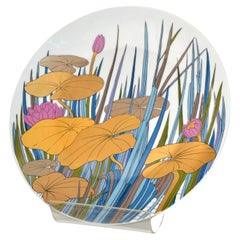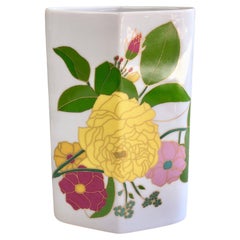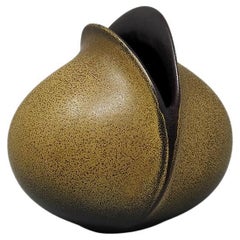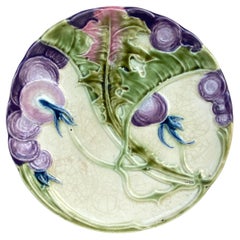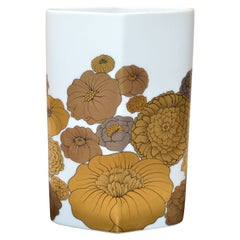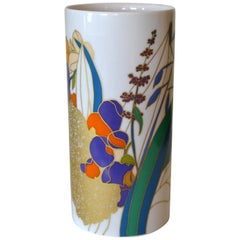Wolfgang Bauer Furniture
to
1
1
2
2
Original Rosenthal Porcelain Flower Plate Studio-Linie Germany by Wolfgang Bauer
By Rosenthal, Wolfgang Bauer
Located in Miami, FL
Striking original Rosenthal porcelain hand painted flower plate designed by Wolfgang Bauer and made in Germany for Studio-Linie.
This 100 Years Anniversary Collectable Wall Plate...
Category
Late 20th Century German Mid-Century Modern Wolfgang Bauer Furniture
Materials
Gold Leaf
Abstract Floral Vase Rosenthal Studio-Line, by Wolfgang Bauer 1970s, Germany
By Rosenthal, Wolfgang Bauer
Located in Andernach, DE
1970s - 1980s vase by Rosenthal, Studio-Line. Wonderful colourful abstract shape and decoration:
flowers in bright pastel colours with golden outlines on a cr...
Category
Late 20th Century German Mid-Century Modern Wolfgang Bauer Furniture
Materials
Porcelain
Related Items
1970s "Venus" Vase by Uta Feyl for Rosenthal Studio Line
By Uta Feyl
Located in Milano, IT
1970s "Venus" Vase in ceramic by Uta Feyl for Rosenthal Studio Line. It's signed at the bottom and in excellent condition. Made in Germany
Dimension:
diameter 5 x 5,1 H inches
diam...
Category
1970s German Mid-Century Modern Vintage Wolfgang Bauer Furniture
Materials
Ceramic
German Majolica Flowers Plate circa 1900
Located in Austin, TX
Small German Majolica Flowers Plate circa 1900.
Category
Early 1900s German Rustic Antique Wolfgang Bauer Furniture
Materials
Ceramic
French Oyster Plate Porcelain Flowers Limoges
By Limoges
Located in Austin, TX
French Oyster Plate Porcelain Flowers Limoges circa 1900.
Category
Early 1900s French Aesthetic Movement Antique Wolfgang Bauer Furniture
Materials
Porcelain
Rosenthal Studio Line Porcelain Plate by Björn Wiinblad 'Limited Edition'
By Bjorn Wiinblad, Rosenthal
Located in Waddinxveen, ZH
Stunning wall plaque by Bjorn
Wiinblad for Rosenthal. The plaque was produced in 1975 in an edition of 5000, and this one is number 1328.
The text on the plate is German ‘auch die...
Category
1970s German Mid-Century Modern Vintage Wolfgang Bauer Furniture
Materials
Porcelain
Classic Rosenthal Turnus 24 % Lead Crystal Glass Vase Vessel Studio Line Germany
By Rosenthal
Located in Miami, FL
Striking original Rosenthal Turnus Geometric Lead crystal glass vase, Vessel by Rosenthal Studio Line made in Germany.
Marked with black foil label Rosenthal classic, 24% lead-cryst...
Category
1980s German Mid-Century Modern Vintage Wolfgang Bauer Furniture
Materials
Crystal
$155
H 3.5 in W 3 in D 3 in
Bjørn Wiinblad Porcelain Pillow Vase for Rosenthal Studio Line, Germany, c.1980
By Bjørn Wiinblad, Rosenthal
Located in San Juan Capistrano, CA
Bjørn Wiinblad Porcelain Pillow Vase for Rosenthal Studio Line, Germany, c.1980.
Category
20th Century German Modern Wolfgang Bauer Furniture
Materials
Porcelain
$360 Sale Price
20% Off
H 8.13 in W 7.5 in D 3.38 in
7 Hand Painted & Signed by Wiinblad Porcelain Christmas Plates, Rosenthal, 1970s
By Rosenthal, Bjørn Wiinblad
Located in Andernach, DE
Bjorn Wiinblad, Danish artist, has created this beautiful series for German art glass & porcelain makers Rosenthal for their Studio-Line art edition.
Plates from 1975 with the Annunc...
Category
Late 20th Century German Mid-Century Modern Wolfgang Bauer Furniture
Materials
Porcelain
$817 Sale Price / set
25% Off
H 0.63 in Dm 11.23 in
Christmas 1979 Wall Plate by Wiinblad, Hand Painted Gold Porcelain, Rosenthal
By Bjørn Wiinblad, Rosenthal
Located in Andernach, DE
Bjorn Wiinblad, Danish artist, has created this beautiful series for German art glass & porcelain makers Rosenthal for their Studio-Line art edition.
This plate is the 1979 edition, ...
Category
Mid-20th Century German Mid-Century Modern Wolfgang Bauer Furniture
Materials
Porcelain
$228 Sale Price
35% Off
H 0.63 in Dm 11.23 in
German White Matte Porcelain Vase by Rosenthal Studio Line
By Rosenthal
Located in New York, NY
A German white matte porcelain vase by Rosenthal Studio-Line Collection, circa late-20th century, Germany. Oval in shape with organic modern design on around - front, side and back. Maker's mark on bottom...
Category
Late 20th Century German Organic Modern Wolfgang Bauer Furniture
Materials
Ceramic, Porcelain
Vintage Kaiser Plate “Ming” Orange Porcelain Wall Plate, Germany
By Kaiser
Located in Bastogne, BE
Vintage big Kaiser plate “Ming” collection.
Famous West Germany Manufacture Kaiser.
Time-Tasted high quality porcelain.
Beautiful Collection “Min...
Category
20th Century German Chinoiserie Wolfgang Bauer Furniture
Materials
Porcelain
Gianni Versace For Rosenthal le Voyage de Marco Polo Porcelain Plate
By Gianni Versace, Rosenthal
Located in Moreno Valley, CA
Gianni Versace "le Voyage de Marco Polo" for Rosenthal.
Designed in Italy by Gianni Versace for Rosenthal. "Le voyage de Marco Polo" porcelain service plate with gold decoration, bri...
Category
Late 20th Century Italian Chinoiserie Wolfgang Bauer Furniture
Materials
Porcelain
Porcelain Vase by Björn Wiinblad Rosenthal Studio Line Germany, 1970
By Bjørn Wiinblad, Rosenthal
Located in Kirchlengern, DE
Article:
Op Art porcelain vase
Producer:
Rosenthal, Germany
Designer:
Björn Wiinblad
Decade:
1970s
This original vintage Op Art vase was produ...
Category
Late 20th Century German Mid-Century Modern Wolfgang Bauer Furniture
Materials
Porcelain
Previously Available Items
Original Rosenthal Porcelain & Gold Vase Studio-Linie Germany by Wolfgang Bauer
By Wolfgang Bauer, Rosenthal
Located in Miami, FL
Striking original Rosenthal porcelain hand painted gold flower vase designed by Wolfgang Bauer and made in Germany for Studio-Linie.
The vase feature...
Category
1950s German Mid-Century Modern Vintage Wolfgang Bauer Furniture
Materials
Gold Leaf
H 8.5 in W 5.5 in D 2.75 in
Original Rosenthal Porcelain Flower Vase Studio-Linie Germany by Wolfgang Bauer
By Wolfgang Bauer, Rosenthal
Located in Miami, FL
Striking original Rosenthal porcelain hand painted flower vase designed by Wolfgang Bauer and made in Germany for Studio-Linie.
The vase features...
Category
1950s German Mid-Century Modern Vintage Wolfgang Bauer Furniture
Materials
Gold Leaf
Floral Porcelain Vase by Rosenthal
By Wolfgang Bauer, Rosenthal
Located in New York, NY
An exceptional floral-patterned porcelain pillow vase from the Summer collection designed by Wolfgang Bauer for Rosenthal Studio Linie. Germany, circa 1960. Signed. Features multi...
Category
1960s German Mid-Century Modern Vintage Wolfgang Bauer Furniture
Materials
Porcelain
Wolfgang Bauer furniture for sale on 1stDibs.
Wolfgang Bauer furniture are available for sale on 1stDibs. These distinctive items are frequently made of porcelain and are designed with extraordinary care. There are many options to choose from in our collection of Wolfgang Bauer furniture, although brown editions of this piece are particularly popular. Many of the original furniture by Wolfgang Bauer were created in the mid-century modern style in germany during the 20th century. If you’re looking for additional options, many customers also consider furniture by Uta Feyl, Hans Theo Baumann, and Wallendorf. Prices for Wolfgang Bauer furniture can differ depending upon size, time period and other attributes — on 1stDibs, these items begin at $211 and can go as high as $550, while a piece like these, on average, fetch $381.
